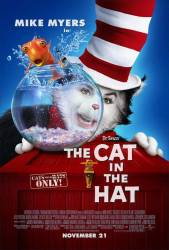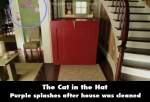Trivia: Mike Myers clicks his fingers to left and then the right of his face and then moves his waist up in a circular motion. He did the same thing in Austin Powers: The Spy Who Shagged Me.
Trivia: When the kids are signing the contract and discover the Spray & Neuter certificate, the date of birth on the certificate is 25 May 1963, which is Mike Myers' own birthday.
Trivia: When the dog runs out we can see another dog in a doghouse, it's the same dog from Men In Black, and it's also called Frank.
Trivia: Due to the mature themes of the film (the acronym of the Cat's car is S.H.I.T, etc.), the widow of the late Dr. Seuss declared that there would be no more live action films made based on her husband's books.







Chosen answer: Theodor Seuss Geisel, or Dr. Suess as we know him, published most of his books between the late 1930's and the late 1980's. "The Cat in the Hat" was first published in 1957. Dr. Seuss' works generally tell the stories of fantastical characters in imaginary places, meant to be timeless. Illustrations and animated adaptations show buildings and objects with unusual proportions, odd shapes and bizarre functions. The live action film of "The Cat in the Hat, " however, is rooted to reality by its decidedly human child protagonists in an ordinary house in an ordinary neighborhood. The production design, costume design and set decoration of the 2003 film seem also to have the goal of achieving a certain timelessness. No date reference is given. However, there a decidedly stylized quality of 1950's-1960's suburban architecture and design, complete with its generic forms, chimneys, picket fences, and colors such as yellows and avocado greens, reflecting the common decor of the time. Similar to the 1971 TV short, which seems to provide a reference point for the design aesthetic of the film, nothing appears exceedingly futuristic nor rooted in period styles like victorian or colonial. I have also posed your question to Rita Ryack, the film's costume designer, whom I found on Facebook. If she sees my questions and decides to respond, I will add her insights to this answer.